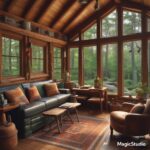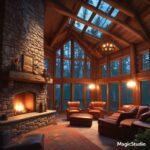The small house movement continues to be active, changing, integrating innovation and sustainability, and responding to the increased desire for minimalism and intentional living. The small-space living world will be alive and well in 2025 with sensational trends that change people’s notion of compact homes. Whether you’re an enthusiast dreaming of downsizing or already living a tiny life, these trends are shaping the future of small-space design and functionality.
1. Multi-Functional Furniture Takes Center Stage
In such a small space, every piece of furniture has to do the job of many items. Multi-functional furniture is at the forefront, leading the charge in space-efficiency and good design, in 2025.
Popular innovations include: Popular innovations include:
Foldable and modular sofas that can function as a bed or storage device.
Expandable dining tables can be transformed from a small table for 2 people to a dining room table for a crowd.
*Hidden storage systems, e.g., stairs with embedded storage space, coffee and table,e with collapsible plateaus.
In line with this trend, it is demonstrated that it is possible to design small homes that meet both in terms of functionality and aesthetic desirability.
2. Smart Technology Integration
Smarter and smarter, miniature houses are possible thanks to the technological improvements that allow new functionalities, such as efficiency and comfort. Smart home systems are tailored to the needs of small environments, delivering intuitive control for lighting, temperature, etc.
Key tech trends include: Key tech trends include:
Intelligent control thermostats that maximize energy saving while providing optimal temperature control for your house.
Voice-controlled agents, including, blinds or appliance control systems.
- Compact home security systems tailored for smaller footprints.
Not only are these technologies practical, but they also align with plans for small living (Sustainability goals).
3. Off-grid and Sustainable Living
Sustainability is underlying all phases of the tiny house movement and 2025 will be the year, as tiny home numbers leap exponentially, when the off-grid tiny homes scene will be noticeable. A growing number of people are substituting renewable energy from the grid with alternative and self-sufficient designs to reduce the environmental impact they have.
Notable features include: Notable features include:
- Solar panels for renewable energy generation.
- Rainwater harvesting systems for sustainable water use.
Composting toilets and greywater recycling systems for waste reduction.
This trend is an offshoot of the idea that humans and the natural world can coexist with low utility consumption.
4. Biophilic Design for Wellness
Biophilic design, which emphasizes connecting with nature, is becoming a staple in tiny home interiors. In limited areas, this leads to a feeling of calm and wellness through the use of natural products and plants.
Elements of biophilic design include: Elements of biophilic design include:
Large windows and rooms within for use of natural light and to give a view of the surrounding outside world.
Indoor plants, vertical gardens, or small green walls bring the “green space” inside.
Organic composites (e.g., reclaimed timber, rock, natural fiber).
This trend aligns well with the simplicity and mindfulness of tiny living.
5. Customization for Individual Lifestyles
One-size-fits-all (O-S-F-A) designs are no longer the way of thought in the building of small houses. At the domestic level, homeowners are continuing to seek out custom-designed spaces that are uniquely suited to their interests and activities.
Examples of this trend include: Examples of this trend include:
- Compact home offices for remote workers.
Tiny homes with workout spaces or yoga nooks.
Unique storage options for arts and crafts, instruments, and outdoor hobbies.
Adaptivemization guarantees that even the most modest house is ideally suited to the occupant’s wishes.
6. Modern Aesthetic Meets Rustic Charm
Interior design, in which both fashionable interior design and traditional rustic attraction are combined, remains the trendiest topic for interior decorating of tiny houses. This hybrid approach can be employed to achieve a welcoming yet modern interior atmosphere.
Key design choices include: Key design choices include:
Gloss finishes such as matte black or brushed metal and reclaimed wood elements.
Omnidirectional lines and cabinet design with open shelves to create unity.
Monochromes in neutral color schemes with a predominance of warm and natural colors and textures.
This trend demonstrates the chic nature of tiny homes without the feeling of being overcrowded.
7. Expanding Outdoor Living Spaces
Outdoor space is as much a part of tiny home living as the inner space is. Homeowners are creating increasingly outdoor spaces that match their interiors, effectively doubling the usable space.
Outdoor living trends include: Outdoor living trends include:
Wraparound decks or patios with seating and dining space.
Grilling, sink, and prep station outdoor kitchens.
Fire pits and hammocks to enjoy evenings stargazing.
These characteristics lead to a natural flow between inside and outside, and consequently in an enhancement of the overall tiny living experience.
8. Tiny Homes on Wheels (THOWs)
Portable houses (tiny houses on wheels) remain a viable choice for people who want to move around or explore. Designs of THOWs in 2025 are on the verge of a fresh era of innovations with the ultimate goal of roadside comfort.
Advancements include: Advancements include:
- Lightweight yet durable materials to improve towing efficiency.
- Off-grid capabilities for extended stays in remote locations.
Smart storage/place concepts for ensuring optimization of space while maintaining a weightless design.
THOWs are attracting an expanding user base of those searching for freedom and flexibility in their tiny living experience.
9. Space-Saving Appliances
Appliances in “tiny homes” are getting smaller, smarter, and more efficient. Within the space scenario of small spaces, from compact washing machines to multi-functional kitchen appliances, these apparatuses are designed for small spaces.
Popular options include: Popular options include:
- All-in-one washer-dryer units that save space and energy.
Induction cooktops can be used as a replacement for the countertop surface when the cooktop is not in use.
Small refrigerator and dishwasher units that provide stable functionality while being thin.
These appliances show that the compromise of size is not the compromise of ease of use.
10. Community-Focused Living
Another trend that stands out is the growing number of tiny home communities, where people with a shared interest gather to share experiences and thoughts. Social integration and autonomy are offered by these villages so that social connection can be conducted with miniaturization.
Features of tiny home villages often include:
- Shared gardens, workshops, or recreational spaces.
- Cooperative energy systems, such as community solar grids.
- Opportunities for communal events and skill-sharing.
This movement trend serves as an example of the collaborative spirit behind the tiny house movement and as a network of support for its occupants.
Conclusion
The tiny home movement in 2025 is more than just a trend—it’s a revolution in how we approach housing, sustainability, and lifestyle design. Innovations, including multi-purpose furniture, smart systems, and biophilic design, are still pushing the boundaries of what can be accomplished, given the relatively small footprint, in the limited space of compact housing.
Whether you’re drawn to the freedom of a THOW, the charm of rustic-modern interiors, or the sustainability of off-grid living, there’s never been a better time to embrace the tiny living lifestyle. Just by watching these developments, you can build a tiny home that is not only practical but also an expression of what you believe in and who you are.










